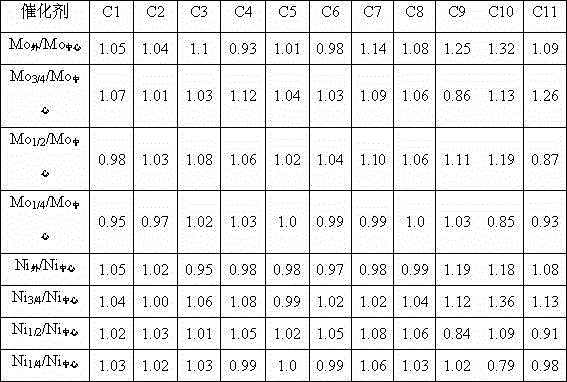Method for preparing residual oil hydro-demetallization catalyst
A technology for hydrogenation and demetallization of residual oil, which is applied in metal/metal oxide/metal hydroxide catalysts, catalyst carriers, chemical instruments and methods, etc. Polarity enhancement, maintaining uniform distribution
- Summary
- Abstract
- Description
- Claims
- Application Information
AI Technical Summary
Problems solved by technology
Method used
Image
Examples
Embodiment 1
[0023] Weigh the pore volume as 0.9ml / g and the specific surface area as 220m 2 100 grams of γ-phase cylindrical strip-shaped alumina carrier / g is added in the polytetrafluoroethylene liner of the autoclave, and 150 ml of aqueous solution of 228 grams of xylitol (xylitol and Al 3+ The molar ratio is 1:1) and impregnated for 60 minutes. After impregnation, the autoclave was sealed and transferred to an oven for heat treatment at 80°C for 120 minutes, then heated to 180°C, carbonized under autogenous pressure for 9 hours, and naturally cooled to room temperature. The alumina carrier after hydrothermal treatment was dried at 120° C. for 3 hours. The dried carrier was activated in 15wt% hydrogen peroxide at 50°C for 3 hours, and then dried with 150ml of MoO 3 105 grams (molybdenum source comes from ammonium molybdate), NiO 15 grams (nickel source comes from nickel chloride) impregnating the above carrier for 3 hours, filter off the excess solution, and dry at 110°C for 8 hours. ...
Embodiment 2
[0025] With embodiment 1, just aluminum oxide carrier is dissolved with the aqueous solution of 136.5 grams of sorbitol (sorbitol and Al 3+ The molar ratio is 0.5:1) impregnation for 120 minutes, the heat treatment temperature is 130°C, and the heat treatment time is 60 minutes. During the carbonization treatment, the temperature was 200° C., and the carbonization time was 8 hours. The concentration of hydrogen peroxide during activation is 20wt%, the activation temperature is 55°C, and the activation time is 2 hours. Active component impregnation process with 150ml containing MoO 3 85 grams (molybdenum source comes from ammonium molybdate), NiO 10 grams (nickel source comes from nickel nitrate) impregnation solution. The residue hydrodemetallization catalyst C2 of the present invention is obtained.
Embodiment 3
[0027] With embodiment 1, just aluminum oxide carrier is dissolved with the aqueous solution of 81.9 gram mannitols (mannitol and Al 3+Mole is 0.3:1) impregnated for 60 minutes. The heat treatment temperature was 100° C., and the heat treatment time was 90 minutes. During the carbonization treatment, the temperature was 240° C., and the carbonization time was 12 hours. The concentration of hydrogen peroxide during activation is 10wt%, the activation temperature is 60°C, and the activation time is 4 hours. Active component impregnation process with 150ml containing MoO 3 115 grams (molybdenum source comes from ammonium molybdate), NiO 15 grams (nickel source comes from basic nickel carbonate) for impregnation. The residue hydrodemetallization catalyst C3 of the present invention is obtained.
PUM
 Login to View More
Login to View More Abstract
Description
Claims
Application Information
 Login to View More
Login to View More - R&D
- Intellectual Property
- Life Sciences
- Materials
- Tech Scout
- Unparalleled Data Quality
- Higher Quality Content
- 60% Fewer Hallucinations
Browse by: Latest US Patents, China's latest patents, Technical Efficacy Thesaurus, Application Domain, Technology Topic, Popular Technical Reports.
© 2025 PatSnap. All rights reserved.Legal|Privacy policy|Modern Slavery Act Transparency Statement|Sitemap|About US| Contact US: help@patsnap.com


